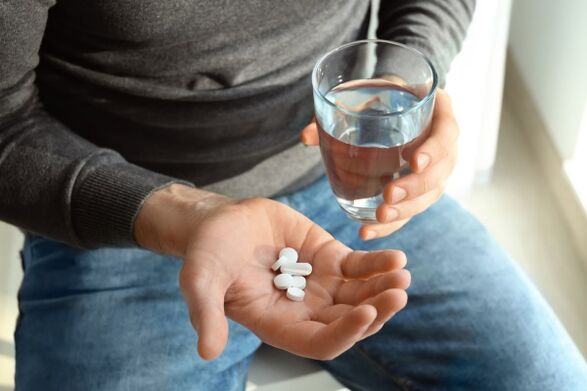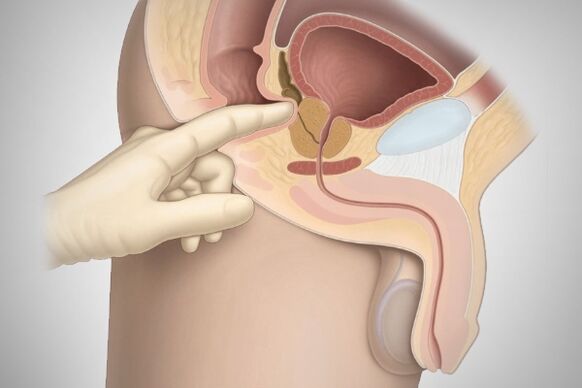Sometimes men face an unpleasant disease like bacterial prostatitis. In order to start treatment on time, it is important to know what signs can define the disease and what diagnosis and therapy will be needed.
Bacterial prostatitis is an infectious disease of the prostate gland. Symptoms of the disease include pain in the perineum, increase in body temperature, intoxication of the body and other signs. Such a condition may require urgent hospitalization as it may endanger the patient’s health and life.
Forms of bacterial prostatitis
According to the identified course and symptoms, bacterial prostatitis is divided into two forms - acute and chronic.
Sharp
The acute form manifests itself suddenly and is accompanied by various unpleasant symptoms. The acute form of bacterial prostatitis requires immediate medical attention. This pathological process is provoked by Escherichia coli, staphylococci, enterobacteria.
Acute prostatitis is easily diagnosed using laboratory tests. Severe symptoms and clinical picture give an accurate diagnosis. Treatment of this form of prostatitis using a combination of drugs and physiotherapy.
Chronic
Chronic bacterial prostatitis has a pathogenic agent that can be detected using laboratory tests and studies. The main pathogens are gonococci, chlamydia, ureaplasma, mycoplasma. The inflammatory process can also be caused by tuberculosis bacteria or fungi of the genus Candida if a man has HIV infection.
Types of bacterial prostatitis
Bacterial prostatitis is classified according to the type of pathogen:
- Tuberculous (Koch's bacillus);
- Gonorrhea (gonococci);
- Fungal (different types of fungi);
- Chlamydial (chlamydia);
- Viral (herpes-causing agents, human papillomavirus, influenza);
- Mixed (several different infections).
Only in laboratory conditions is it possible to determine what was causing it, since the symptoms are the same for everyone.
Causes and risk factors
Bacteria enter the prostate gland, causing acute or chronic prostatitis. Sexually transmitted diseases can also cause this disease. In some cases, the cause cannot be determined.
Causing agentsBacterial prostatitis is considered:
- colibacillus;
- Klebsiela;
- Proteus;
- Fecal enterococci;
- Pseudomonas aeruginosa.
It is possibleMicrobiological causesProstatitis is:
- Staphylococci (beneficial, golden, epidermal);
- Genital mycoplasma;
- chlamydia trachomatis;
- Ureaplasma;
- Trichomonas.
TORisk factorsInfection of the prostate gland with the further development of the inflammatory process in one form or another of bacterial prostatitis is:
- Intraprostatic reflux (urinary reflux during urination into the prostate ducts);
- Pelvic injury;
- Unprotected anal sex;
- Urinary tract infections;
- Intrauterine catheter or intermittent catheterization of the bladder;
- Transurethral diagnostic and therapeutic interventions;
- HIV AIDS;
- Prostate biopsy.
Symptoms of bacterial prostatitis
Usually with bacterial prostatitis, the symptoms are so pronounced that it is difficult not to pay attention to them. Signs of the disease are:
- High body temperature (usually higher in the anus than in the arms);
- Fever and chills;
- Difficult and painful urination, especially at night;
- Possible development of constipation due to enlargement of the prostate gland;
- Pain in the lower part of the body (lower back, perineum, lower abdomen);
- General intoxication of the body;
- Discharge from the urethra and blood in the semen.

Stages of bacterial prostatitis
The clinical picture of bacterial prostatitis is revealed according to the stage of the disease and the degree of involvement of prostate tissue during the inflammatory process. share:
- Primary or catarrhal prostatitis.Characterized by inflammation of the walls of the prostate gland. It is quite possible to cure it with antibiotics in 10 days.
- Secondary or follicular.It is characterized by the formation of abscesses in the glandular tissue. It is accompanied by a high fever. This form is also effectively treated with antibacterial drugs.
- Tertiary or parenchymal.At this stage the pathological process spreads throughout the body - the prostate grows in size, swells and changes shape. If you do not get treatment on time, then the third stage can turn into chronic prostatitis.
Possible complications and consequences in men
Outcomes and complications of bacterial prostatitis include:
- Vesiculitis (inflammation of the seminal vesicles) - manifested by abdominal pain, premature ejaculation, painful erection;
- Coliculitis (inflammation of the testicles) - differs in a variety of symptoms - burning and tingling in the posterior urethra, painful sensations during orgasm, blood in the semen;
- Potency disorder;
- Prostate sclerosis;
- Infertility;
- Prostate cyst;
- Prostate abscess;
- Stones in the prostate gland.
Chronic pelvic pain syndrome is one of the most severe consequences of chronic prostatitis.
Asymptomatic inflammation is the mildest form in the absence of any complaints. This type of prostatitis is diagnosed with the development of complications of reproductive function.
Is bacterial prostatitis dangerous for women?
Prostatitis does not occur in women, but its serious consequences are frequent. If a man is suffering from bacterial prostatitis, it is simply irresponsible to say that the woman is not in danger: chlamydia, ureaplasma, trichomonas, mycoplasma, gonococcus, Gardnerella and other infections from a partner pose a serious risk of developing various diseases.
Which doctor treats you?
UrologistHe is considered to be the main specialist in the diagnosis and treatment of pathological conditions of the genital system.
Andrologist.Although andrology belongs to a rather young field of medicine, specialists in this field are gradually taking their place in the treatment of diseases of the male genital system. The advantage of this doctor is his narrow attention. Unlike a urologist who treats diseases of the male and female genital systems, an andrologist specializes only in male problems.
Diagnosis of bacterial prostatitis
If bacterial prostatitis is suspected, a number of tests are performed, including:
- Scratches and smears for infection;
- Flora and antibiotic susceptibility cultures;
- A general blood test helps to detect the inflammatory process when there is an increase in the number of leukocytes, an increase in ESR;
- Spermogram, which examines the reduction in the number of sperm, the disruption of their mobility;
- Three glass urine sample (to examine inflammatory changes in urine);
- General urinalysis;
- Analysis of prostate secretion;
- Uroflowmetry - monitoring of daily urine output.
The doctor will be able to assess how enlarged the prostate is by examining the digital rectum. Your doctor may order a transsexual ultrasound scan to find out the diagnosis.
Bacterial treatment of prostatitis
As a therapy for bacterial prostatitis, medications, physiotherapy, folk remedies and surgery in severe cases are prescribed.
Drug treatment
Medical treatment of prostatitis is carried out using different groups of drugs. These may be antibiotics to neutralize the pathogen. However, they do not always help, since the prostate gland is characterized by a group of penicillins protected from poor absorption of antibiotics, fluoroquinolones.
The course of treatment is usually 10-14 days and it should definitely be completed because if the bacterial prostatitis is not treated, it will reappear. Vitamins and medications are also prescribed to strengthen the immune system.

surgery
The doctor recommends prostatitis surgery if the result is not achieved in treating the patient with medication, physiotherapy or alternative methods of treatment.
Surgical intervention includes the following procedures:
- Transurethral resection of the prostate.The inner part of the body is removed. Surgery is the most commonly used and best endoscopic treatment for benign prostatic hyperplasia.
To perform this intervention, the patient undergoes numerous tests, including blood and urine tests. The operation is performed under spinal anesthesia, but general anesthesia can also be used. There are no scars after the operation. Among the disadvantages is painful urination in the first days after the procedure. - Laser surgery.The laser destroys the diseased tissue. At the same time, the size of the prostate is reduced, and the vessels are "sealed" and do not bleed. The operation is performed without wounds and the postoperative period is only three days. Blood and urine tests are performed before the intervention, as well as ultrasound of the urinary tract and, according to the doctor's prescription, a prostate biopsy is performed.
This method is not effective if the prostate volume is large. - Open prostatectomy.Surgery is performed in cases where the prostate is significantly enlarged, in case of complications and bladder damage.
The surgeon makes an incision in the lower abdomen, or between the cavity and the anus. Part of the prostate is removed, or completely.
Ultrasound, MRI and cytoscopy, as well as blood and urine tests and a prostate-specific antigen test are performed before surgery.
One of the advantages of surgery is its effectiveness in treating prostate and related problems. And on the downside - a long period of postoperative recovery (more than a month), as well as problems with erectile function. - Transurethral incision of the prostate gland.The doctor does not remove the prostate tissue, but only makes an incision to relieve pressure on the urethra, thus facilitating urination. Blood and urine tests are performed before the operation, as well as ultrasound of the urinary tract.
Advantages of the procedure - the symptoms of prostatitis go away without the risk of retrograde ejaculation, no long recovery is required. Disadvantages - Prostatitis still needs treatment. - Prostate abscess drainage.The doctor removes the abscess through the perineum or rectum, cuts the skin and subcutaneous tissue, and places drainage into the cavity with purulent removal.
Consult a proctologist, blood and urine tests before the operation.
The advantages of surgery include the absence of risk of loss of sexual function. The disadvantages are that the abscess may not be completely removed and the bacteria may spread throughout the body.
Surgery for prostatitis in men is usually the last resort for chronic bacterial prostatitis associated with any form of complication.
Physiotherapy
Physical methods of influence are of great importance in the complex treatment of patients diagnosed with prostatitis. The following have been improved as a result of physiotherapy procedures:
- Blood circulation;
- Lymphatic drainage, which helps to eliminate the breakdown products of microorganisms;
- Blood and lymph circulation, which stops inflammatory infiltrates;
- Blood and lymph drainage, which helps reduce pelvic swelling;
- Metabolism;
- The action of cell membranes, which facilitates the penetration of active drugs into the cell.
Physiotherapy for bacterial prostatitis includes the following methods:
- Electrophoresis.Exposure to the body with ions, which helps to alleviate inflammation and eliminate pain.
- Laser physiotherapy.The laser helps relieve perineal pain and improves blood flow to the pelvic organs. It kills bacteria and removes waste from pests.
- Magnetotherapy.Tissue permeability is improved during this procedure and the effectiveness of drug therapy is significantly increased. In addition, hemodynamics and edema are stopped with the help of magnetotherapy.
Exercise for bacterial prostatitis
For chronic prostatitis, exercise causes contraction of the muscles in the pelvic region, which guarantees a difference in intra-abdominal pressure. It promotes blood circulation to the prostate. Exercise strengthens the nervous system, stimulates the adrenal glands and removes the residual effects of inflammatory diseases in the prostate.
You can do the following exercises at home:
- The man sits on a rubber ball and spins from left to right, slightly spring. This helps strengthen the pelvic floor muscles and obliques.
- Kegel exercises. Tighten the buttocks as much as possible for 5-10 seconds, then relax the muscles. This exercise is held 20-50 times.
- Lie on your back, bend your knees and place your heels on the floor. Slowly raise your pelvis and place your upper body on the floor. When the pelvis is at the top point, you should freeze for 15 seconds and then return to the original position. Number of repetitions 10-15 times.
Do a massage
To achieve the result, exercises are held every day and they are also supplemented with prostate massage, which can be performed both independently and with the help of special massagers.
Prostate massage is performed as follows:
- Drink a liter of water one hour before the procedure to fill the bladder.
- Clean the intestines with an enema based on a solution of potassium permanganate or chamomile infusion. The crutch should be rinsed.
- Hands should be washed thoroughly and nails cut short.
- You will need to wear a glove or condom on your finger that will be used for the massage.
- The rubber surface of the protective layer is lubricated with oil, grease or baby cream.
- Start in a comfortable position and insert a finger into the anus to a depth of 5 cm.
- On the anterior wall you can feel the prostate gland and start stimulating it with light blows from the sides to the center.
- In severe areas, the pressure gradually increases, and in soft areas - decreases.
- In the final stage, striking movements are made down along the central goji.
- Gently remove a finger from the anus.

During the massage you should release 3-5 drops of fluid (prostate juice). As soon as the massage is over, you should go to the toilet and empty the bladder.
Diet therapy
During prostatitis it is necessary to minimize the consumption of alcohol and cigarettes. Doctors also recommend excluding from the diet:
- Fatty foods, particularly meat, because fat is a source of "bad" cholesterol, which disrupts blood circulation and adversely affects the prostate;
- Energy and synthetic drinks;
- Spices;
- Spicy and smoked.
It is advisable to eat cooked and cooked food, lots of vegetables and herbs.
Folk remedies
Pumpkin seed.Pumpkin seeds are an old remedy for prostatitis. They contain a lot of zinc, which a man's body needs. You should eat 30 seeds a day before meals.
Brown branches.Boil a few sprigs of hazelnuts in water for 20 minutes, stirring until the broth turns reddish-brown. A weekly course is sufficient for treatment.
Aspen bark.Aspen bark should be collected at the beginning of the sap flow period, before the buds bloom. It is about the second half of April. Dry the crust in the oven, take 100 g, grind and put in a half-liter jar. Pour 200 g of vodka so that the crust is completely covered. Close the jar and place in a dark place for 2 weeks. Filter after 2 weeks. Take 1 teaspoon at a three-week course with a 10-day break.
Prognosis for bacterial prostatitis
The prognosis of prostatitis of bacterial origin depends on the stage and type of the disease. The duration of the disease also affects the prognosis - the longer the inflammation persists, the longer it takes to treat the complications of prostatitis.
The prognosis in acute prostatitis is favorable. Chronic bacterial prostatitis is often a recurrent form, even when conservative therapy is prescribed. With long-term treatment of the chronic form, potential changes may occur.
Preventive measures
Prevention of bacterial prostatitis can be divided into primary and secondary.
Primary prevention of prostatitis:
- Healthy lifestyle;
- Good food;
- Sports game.
It is important to take preventative measures at home - performing exercises that activate blood flow to problem organs and improve muscle tone.
Also, men should study Kegel exercises. They are designed for post-natal recovery in women, but they are used to train men’s anal muscles and rectum.
Gymnastic exercises are useful: bicycle, birch, bridge, candles. They train the pelvic floor muscles. It is advisable to do a foot swing, breathing exercises and take a contrast shower.
Secondary prevention of prostatitis:
- Drug treatment;
- Regular examination by a urologist, regardless of the manifestations;
- For a year after treatment, undergo quarterly examinations, later - once every six months.
Rectal suppositories are used for secondary prophylaxis. They act through the rectum. Usually, these drugs have several contraindications. Also, biologically active drugs are prescribed to prevent recurrence of bacterial prostatitis.
The earlier prostatitis is detected, the easier it is to cure. Therefore, do not neglect regular visits to the doctor. After diagnosis, the doctor selects the appropriate medication and prescribes a therapeutic course. If the disease progresses, timely intake of medication will quickly relieve the symptoms and help you stay active and functional.































